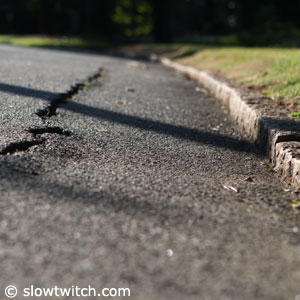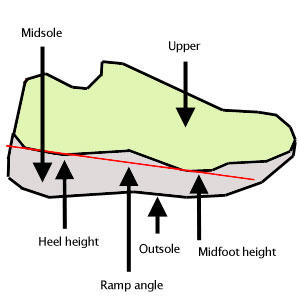
1 of 2 photos
<
>
So I might as well let you know up front that the hardness difference between concrete and asphalt is insignificant when running in shoes, because the cushioning afforded by shoes far exceeds any cushioning provided by those surfaces. When moving to grass or dirt, the contribution of those surfaces to reducing ground impact begins to play a much larger role. It's also clear that runners have many personal experiences running on varied surfaces, and in researching this article, it became clear that some runners are convinced they can sense the impact difference between concrete and asphalt.

2 of 2 photos
<
>
Running Shoe Shock Absorption: The Midsole
Most runners tend to wear shoes, and we all know that the added material beneath our feet act as cushioning, along with the natural cushioning on the soles of our feet. Commonly used in shoes are viscoelastic materials, present in the midsole. These materials are usually known chemically as polyethylene, polyvinyl chloride, polyurethane, among others. As with other elastic materials, these substances provide an effective means to redistribute the pressure underfoot. Since energy cannot be "lost", what occurs is the spread of energy over a greater amount of time and release of some energy in the form of sound and heat. The reduction of overall pressure reduces local pressures and stress on the foot and other skeletal structures as the shockwave of each step promulgates upward through the body. This shockwave can damage soft tissue. Reducing the severity of the impact has been shown to improve overuse injuries including joint pain, stress fractures and possibly even osteoarthritis. In healthy individuals, a 10-20mm pad of fat on the bottom of the foot acts as a "viscoelastic shock absorber". Age, disease, and medication (ie- injected corticosteroids) can degrade the fat pad.
Artificial viscoelastic materials can replace or improve shock absorption. Studies have found that softer foam materials are effective if they are used in significant thickness but tend to deteriorate rapidly with use and can "bottom out" under load. It has been found that insoles that employ multiple materials in concert tend to afford the best overall performance.
Most runners tend to wear shoes, and we all know that the added material beneath our feet act as cushioning, along with the natural cushioning on the soles of our feet. Commonly used in shoes are viscoelastic materials, present in the midsole. These materials are usually known chemically as polyethylene, polyvinyl chloride, polyurethane, among others. As with other elastic materials, these substances provide an effective means to redistribute the pressure underfoot. Since energy cannot be "lost", what occurs is the spread of energy over a greater amount of time and release of some energy in the form of sound and heat. The reduction of overall pressure reduces local pressures and stress on the foot and other skeletal structures as the shockwave of each step promulgates upward through the body. This shockwave can damage soft tissue. Reducing the severity of the impact has been shown to improve overuse injuries including joint pain, stress fractures and possibly even osteoarthritis. In healthy individuals, a 10-20mm pad of fat on the bottom of the foot acts as a "viscoelastic shock absorber". Age, disease, and medication (ie- injected corticosteroids) can degrade the fat pad.
Artificial viscoelastic materials can replace or improve shock absorption. Studies have found that softer foam materials are effective if they are used in significant thickness but tend to deteriorate rapidly with use and can "bottom out" under load. It has been found that insoles that employ multiple materials in concert tend to afford the best overall performance.
PREV
NEXT
1 of 2 photos


>
<



